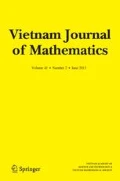Abstract
We will study the presentations of fundamental groups of the complement of complexified real affine line arrangements that do not contain two parallel lines. By Yoshinaga’s minimal presentation, we can give positive homogeneous presentations of the fundamental groups. We consider the associated monoids defined by the presentations. It turns out that, in some cases, left (resp. right) least common multiple does not always exist. Hence, the monoids are neither Garside nor Artin. Nevertheless, we will show that they carry certain particular elements similar to the fundamental elements in Artin monoids and that, by improving the classical method in combinatorial group theory, they are cancellative monoids. As a result, we will show that the word problem can be solved and the center of them is determined.




Similar content being viewed by others
References
Brieskorn, E.: Die Fundamentalgruppe des Raumes der regulären Orbits einer endlichen komplexen Spiegelungsgruppe. Invent. Math. 12, 57–61 (1971)
Bessis, D., Michel, J.: Explicit presentations for exceptional braid groups. Exp. Math. 13, 257–266 (2004)
Brieskorn, E., Saito, K.: Artin-Gruppen und Coxeter-Gruppen. Invent. Math. 17, 245–271 (1972). English trans. by Coleman, C., Corran, R., Crisp, J., Easdown, D., Howlett, R., Jackson, D., Ram, A. at the University of Sydney (1996)
Cheniot, D.: Une démonstration du théorème de Zariski sur les sectionshyperplanes d‘une hypersurface projective et du théorème de van Kampen sur le groupe fondamental du complémentaire d’une courbe projective plane. Compos. Math. 27, 141–158 (1973)
Clifford, A.H., Preston, G.B.: The Algebraic Theory of Semigroups. Mathematical Surveys and Monographs, vol. 7. American Mathematical Society, Providence (1961)
Dehornoy, P.: Groupes de Garside. Ann. Sci. Éc. Norm. Super. 35, 267–306 (2002)
Dehornoy, P.: Complete positive group presentations. J. Algebra 268, 156–197 (2003)
Dehornoy, P.: The subword reversing method. Int. J. Algebra Comput. 21, 71–118 (2011)
Deligne, P.: Les immeubles des tresses généralizé. Invent. Math. 17, 273–302 (1972)
Dehornoy, P., Paris, L.: Gaussian groups and Garside groups, two generalizations of Artin groups. Proc. Lond. Math. Soc. (3) 79, 569–604 (1999)
ElRifai, E., Morton, H.: Algorithms for positive braids. Q. J. Math. Oxf. Ser. 2(45), 479–497 (1994)
Garside, F.A.: The braid groups and other groups. Q. J. Math. Oxf. Ser. 2(20), 235–254 (1969)
Gebhardt, V.: A new approach to the conjugacy problem in Garside groups. J. Algebra 292, 282–302 (2005)
Ishibe, T.: On the monoid in the fundamental group of type \(\mathrm {B_{ii}}\). Hiroshima Math. J. 42, 1–142 (2012)
Ishibe, T.: The skew growth functions N M,deg(t) for the monoid of type B ii and others. Preprint
Oka, M., Sakamoto, K.: Product theorem of the fundamental group of a reducible curve. J. Math. Soc. Jpn. 30, 599–602 (1978)
Picantin, M.: The conjugacy problem in small Gaussian groups. Commun. Algebra 29, 1021–1039 (2001)
Saito, K., Ishibe, T.: Monoids in the fundamental groups of the complement of logarithmic free divisors in \({\mathbb{C}}^{3}\). J. Algebra 344, 137–160 (2011)
Tokunaga, H., Shimada, I.: Algebraic curves and singularities. Part I. Fundamental groups and singularities (2001). Kyoritsu (in Japanese )
Yoshinaga, M.: Hyperplane arrangements and Lefschetz hyperplane section theorem. Kodai Math. J. 30, 157–194 (2007)
Acknowledgements
The author was very glad to participate in the conference JSPS-VAST Japan–Vietnam Bilateral Joint Projects “Topology of Singularities and Related Topics, III” Dalat, Vietnam, 26–30 March 2012. The author thanks all the organizers: Nguyen Viet Dung, Ta Le Loi, Pham Tien Son, Mutsuo Oka and Masaharu Ishikawa. The conference was supported by Japan Society for the Promotion of Science, Vietnamese Academy of Science and Technology, GDRI Singularities France–Japan–Vietnam (CNRS), National Foundation for Science Technology Development. The author is grateful to Kyoji Saito for very interesting discussions and encouragement. This research is supported by JSPS Fellowships for Young Scientists (23⋅10023). This research is also supported by World Premier International Research Center Initiative (WPI Initiative), MEXT, Japan.
Author information
Authors and Affiliations
Corresponding author
Rights and permissions
About this article
Cite this article
Ishibe, T. Infinite Examples of Cancellative Monoids That Do Not Always Have Least Common Multiple. Vietnam J. Math. 42, 305–326 (2014). https://doi.org/10.1007/s10013-014-0062-6
Received:
Accepted:
Published:
Issue Date:
DOI: https://doi.org/10.1007/s10013-014-0062-6




